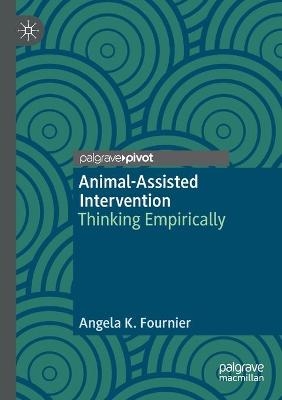
Animal-Assisted Intervention
Springer International Publishing (Verlag)
978-3-030-32974-7 (ISBN)
- Titel ist leider vergriffen;
keine Neuauflage - Artikel merken
lt;br>Angela K. Fournier is Professor of Psychology in the College of Individual and Community Health at Bemidji State University, USA. She is a licensed psychologist and certified mental-health specialist in equine-assisted psychotherapy and learning.
lt;b>Chapter 1: Introduction1.1 Definition1.2 History of Practice & Research1.3 Scientist-Practitioner Approach1.4 Thinking Empirically about Intervention Components1.5 Research Reported Here1.6 Human-Animal Dichotomy1.7 Organization of the Book
Chapter 2: Human-Animal Interaction Analysis2.1 Measurement2.2 Animal-Assisted Intervention Measurement2.3 Measuring Human-Animal Interaction2.4 Instrumentation2.5 Human-Animal Interaction Scale2.5.1 Scale Development2.5.2 Reliability and validity2.6 Human-Animal Interaction Analysis2.6.1 HAI Analysis in the Laboratory2.6.2 HAI Analysis in an Applied Setting2.6.3 Discussion2.7 OHAIRE Behavioral Coding Tool2.8 SummaryChapter 3: HAI Dose in Animal-Assisted Intervention3.1 Animal-Assisted Intervention Dose3.1.1 Session Duration and Frequency3.1.2 HAI Dose3.2 Experimental Manipulation of HAI Dose3.2.1 Mood State Across HAI Dose Conditions3.2.2 Mood State and HAI Dose Correlations3.3 Dose-Response Relationships3.3.1 Dose-Response for Behavioral HAI3.3.2 Dose-Response for Time Spent3.4 Summary and Conclusion on HAI DoseChapter 4: Animals as Anodyne4.1 Anodyne Effect4.2 Anodyne in Animal-Assisted Therapies4.2.1Psychotherapy and Counseling4.2.2 Physical, Occupational, or Recreational Therapies4.3 Anodyne in Animal-Assisted Activities4.3.1 Hospitals and MEdical Centers4.3.2 Nursing Homes4.3.3 Schools4.4 Anodyne in Human-Animal Interaction Research4.5 Human-Horse Interaction and Anodyne4.6 Anodyne Across Species4.7 Discussion4.8 Implications of an Anodyne Effect4.8.1 Attention4.8.2 Attendance4.8.3 Tolerance4.8.4 Cognitive and Behavioral Effects4.9 SummaryChapter 5: Animals as Intervention Agents5.1 Animals as Agents in Mental-Health Intervention5.2 Animals as Agents in Physical-Health Intervention5.3 Why Animals?5.3.1 Animal Agency5.3.2 Animal Characteristics5.3.3 Species5.4 Dogs as Agents in Healthy Expression of Masculinity5.5 Horses as Agents in Psychotherapy and Learning5.5.1 Horses as Agents Through Metaphor5.5.2 Intersection with Traditional Training Models5.5.2.1 A Treatment Modality Within a Therapeutic Orientation5.5.2.2 Intersection of Eagala-Model EAP with CBT5.5.3 The Anodyne-Agent ModelChapter 6: Studying Animal-Assisted Intervention Through Citizen Science6.1 Citizen Science6.2 Citizen Science in Anthrozoology6.3 Citizen Science in Animal-Assisted Intervention6.4 Citizen Science iwth Pet Partners6.4.1 Practitioner Participation6.4.2 Animal-Handler Team Demographics6.4.3 Human-Animal Interaction Analysis6.4.4 Factor Analysis of Behavioral Interactions6.4.5 Role of the Therapy Animal6.4.6 HAI Across Animal Role6.4.7 Discussion6.5 Limitations Specific to Citizen Science6.5.1 Sampling Error6.5.2 Data Quality6.5.3 Validation of Citizen-Science Data6.6 ConclusionChapter 7: Toward Empirical Thinking and Creative Inquiry7.1 Confines and Considerations7.1.1 Scope7.1.2 HAI Analysis7.1.3 Sociocultural Variables an dSocial Justice Issues7.1.4 Animal Autonomy and Welfare7.1.5 Responsible Reporting7.2 Conclusion
| Erscheinungsdatum | 23.12.2020 |
|---|---|
| Zusatzinfo | XXV, 140 p. 28 illus. |
| Verlagsort | Cham |
| Sprache | englisch |
| Maße | 148 x 210 mm |
| Gewicht | 228 g |
| Themenwelt | Geisteswissenschaften ► Psychologie ► Sozialpsychologie |
| Medizin / Pharmazie ► Medizinische Fachgebiete ► Psychiatrie / Psychotherapie | |
| Schlagworte | anthrozoology • Community Health Behavior • ecopsychology • Empirical Methods • Equine-assisted therapy • Hai • Human-Animal Intervention • Human-Nature Interaction • psychotherapy |
| ISBN-10 | 3-030-32974-7 / 3030329747 |
| ISBN-13 | 978-3-030-32974-7 / 9783030329747 |
| Zustand | Neuware |
| Haben Sie eine Frage zum Produkt? |
aus dem Bereich


